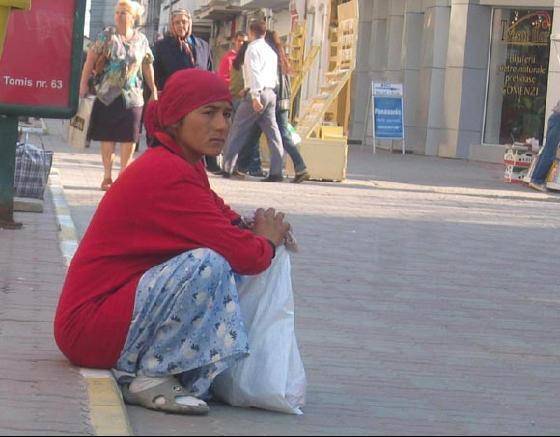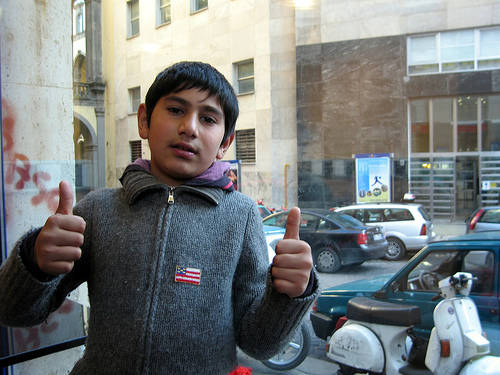In our Churches, On our Beaches. The Gypsies of Italy
On Tuesday evening a band of Gypsies burst into Rome’s 1,700-year-old Basilica of Santa Maria in Trastevere, and stole...Our hearts.
The occasion was a concert by the Rajko Orchestra of Hungary, given a standing ovation for a virtuoso performance sponsored by the Sant’Egidio Community, which has worked with the Roma for decades. The orchestra, composed entirely of Gypsy, or Roma, professional musicians, performed with some eighteen violins, four double basses, clarinets and a zither. Unusual for a church concert in Rome, secular music predominated, and in a show of musical democracy as well as skill, various violinists conducted by turns, occasionally taking a small stroll while tackling Liszt, Massenet, Bach and the like. They could walk about: there were no music stands to get in the way, for not a single musician played from sheet music.
This week particular attention was being paid to the Roma at a pan-European conference organized by the Pontifical Council for the Pastoral Care of Migrants. In this connection, at Wednesday’s general audience at St. Peter’s, where the Rajko Orchestra also performed, Pope Benedict XVI called upon parish churches to make “a more effective commitment toward the Gypsies.” (Although the word Gypsy is often considered pejorative, the pontiff used the word “zingari.”)
Coincidentally, at an academic symposium held under the aegis of the Rome center of the University of California, an Italian social worker with long experience in working with Roma, and three Roma themselves, met with American students. One of the speakers told the students that is integrated into Italian life to the point that his fellow Roma sometimes call him a “Gaggio,” as non-Gypsies are known. “I am here legally, I earn a living, and I am married with children—my daughter is in high school and wants to study law at university. But when I finally had money to rent an apartment in Rome, I was turned away,” he said. He still lives in a container in a camp.
“By sponsoring the concert we wanted to present a different image of the Roma world,” Mario Marazziti, a spokesman for Sant’Egidio, told me.
That image is a problem for the 150,000 or more Roma in Italy, as Nazi-style hate comments on Italian Internet blogs show (and the Nazis killed over 500,000 in Europe). The stereotype in Italy, and not only here, is that all Gypsies are thieves and beggars. A sampler: “They are parasites.” “How come they go around in Mercedes cars?” “Since none of them work, how do they live?” “Send them to a desert island with four tomato seeds.” “In the hospitals you always find Gypsies persecuting patients with demands for money.” “They sneak into the corridors and grab everything in sight.” “No people were ever so detested.” “They are a cancer on society. This isn’t racism—it’s the truth.”
Lamberto Curatolo of the leftist political party Italia dei Valori in Piacenza puts some of this hate talk down to the Roma being trans-national, a condition used to justify “a new racial hatred, aimed at nationalistic self-celebration.”
In fairness, some are thieves. Italy itself has no lack of native thieves, any more than does the US, of course. But the thieving of the Roma is endemic and reflects the fact that generations of the vast majority of adults have never attended school and are hence illiterate and unemployable. The experience of a teacher in our village in North Rome, Trevignano, is typical. Returning home one day from school, she found a Roma woman inside her parlor, trying to make off with the family silver.
Child exploitation is still frequent, and many children are forced to beg. I saw a teenage male Roma musician in Naples forcing a dazed child of five to beg on a commuter train at 10 am when the thermometer showed over 100 degrees. I then saw the same child still begging outdoors in a piazza at 10 pm. A recent documentary film aired on the BBC contained secretly filmed footage showing a girl of ten or so in Milan being beaten by her female Gypsy minder when the girl failed to produce enough alms. Some Roma girls are married off in their early teens to men over twice their age. Many are married as adolescents, and the fallout of these early marriages is the lack of mature guidance for their children.
The children suffer further when the spontaneously created camps in Rome and Milan, the only home they know, are smashed by bulldozers before their terrified eyes. The idea is to persuade Roma families to move into new camps—some not yet built—that are surrounded by high fences and will have electricity, running water and strict police controls over who enters and who exits. A project also exists to fingerprint Roma children, so that they have precise identification. Not surprisingly, some Roma consider the efforts to give them IDs and to fingerprint their children as Gestapo tactics, and the rehousing akin to being put into a concentration camp. Even Father Paolo Cristiano, who has worked with the Roma for 17 years, describes the camps as “ghettos, far from shops and schools.”
So can the Roma be integrated?
Discrimination against them is undeniable. On a Sicilian beach in July 2007 a Roma woman was seen grabbing a child by the arm and concealing the little boy in her long skirts. Alert bathers grabbed her, stopped her from stealing the child and nearly lynched her.
Stealing? The child was running into a street where cars were passing, and, as was later learned, the Roma woman was trying to be helpful. “I have six children of my own,” she told a reporter later. “Whatever would I want with another one?”
Father Paolo Cristiano, who has worked with the Roma for l7 years, believes that Roma could be integrated in the Italian society.
“Their presence in Europe dates back to the 14th Century, but they have always been discriminated. This led to their developing a reaction against civil society. Today, having no documents makes it difficult to find work, and the lack of schooling aggravates this. Then they live in slums, without access to normal housing, and this keeps them apart. But they do want to integrate, have normal documents and send their children to school.” The lack of documents is a particular torment to those wishing to be integrated.
“It is a bureaucratic choice for the convenience of the authorities,” according to Andrea Anzaldi, a representative of the European Roma Rights Centre. One Roma told a reporter in Rome in January that he has been in Italy for 34 years but is still officially a clandestine.
Five years ago a study by the Opera Nomadi, Italy’s largest Roma organization founded in 1963, produced its own in-depth analysis of the problems facing Roma children in school, with reference to the experiences of teachers and social workers. One of the most serious problems is language.
For the children, Italian is often their third language after the Roma language and the language of their East European country. In addition, the Roma culture is oral, yet their own language has a relatively small vocabulary and is not codified. Study, reading, concentration, comprehension, grammar, and the transformation of thought into written form do not come easily, especially in a world in which words are presented as dogma, and can even seem weapons, by the elder.
Yet change is coming, Father Cristiano believes. “Our first goal in working with them is knowledge and friendship—we try to have a personal relationship with every one, adults and children, to learn their basic needs, including spiritual.” At least in Rome, he says, almost all Roma children now go to school, a first necessary step in the difficult process—difficult for Italians as well as Roma—of entering the world of work. Many teachers are supportive, as are parents of non-Roma children who encourage integration. And indeed one Italian teacher wrote a long letter of heart-felt protest about a six-year-old Rom who loved school, but whose schooling was interrupted by the camps being torn down and the family transferred.
And there are other spontaneous efforts to address that negative image as preludes to better integration. In the Northern city of Treviso, in reaction to the torching of a Roma camp two years ago, a club was created that now includes eighty photographers—professionals as well as amateurs—who specialize in photographing life in Roma camps. Last year the XYZ Gallery for Applied Arts held an exhibition of their photos called Zingari d’Italia (Italian Gypsies). The photographers’ goal, according to curators Fabrizio Urettini and Matteo Segna, is: “to liberate us, at least a bit, from the fantasy iconography of the ‘Gypsy’ as romantic, nomadic, criminal, anti-social and subhuman.”

















































i-Italy
Facebook
Google+
This work may not be reproduced, in whole or in part, without prior written permission.
Questo lavoro non può essere riprodotto, in tutto o in parte, senza permesso scritto.